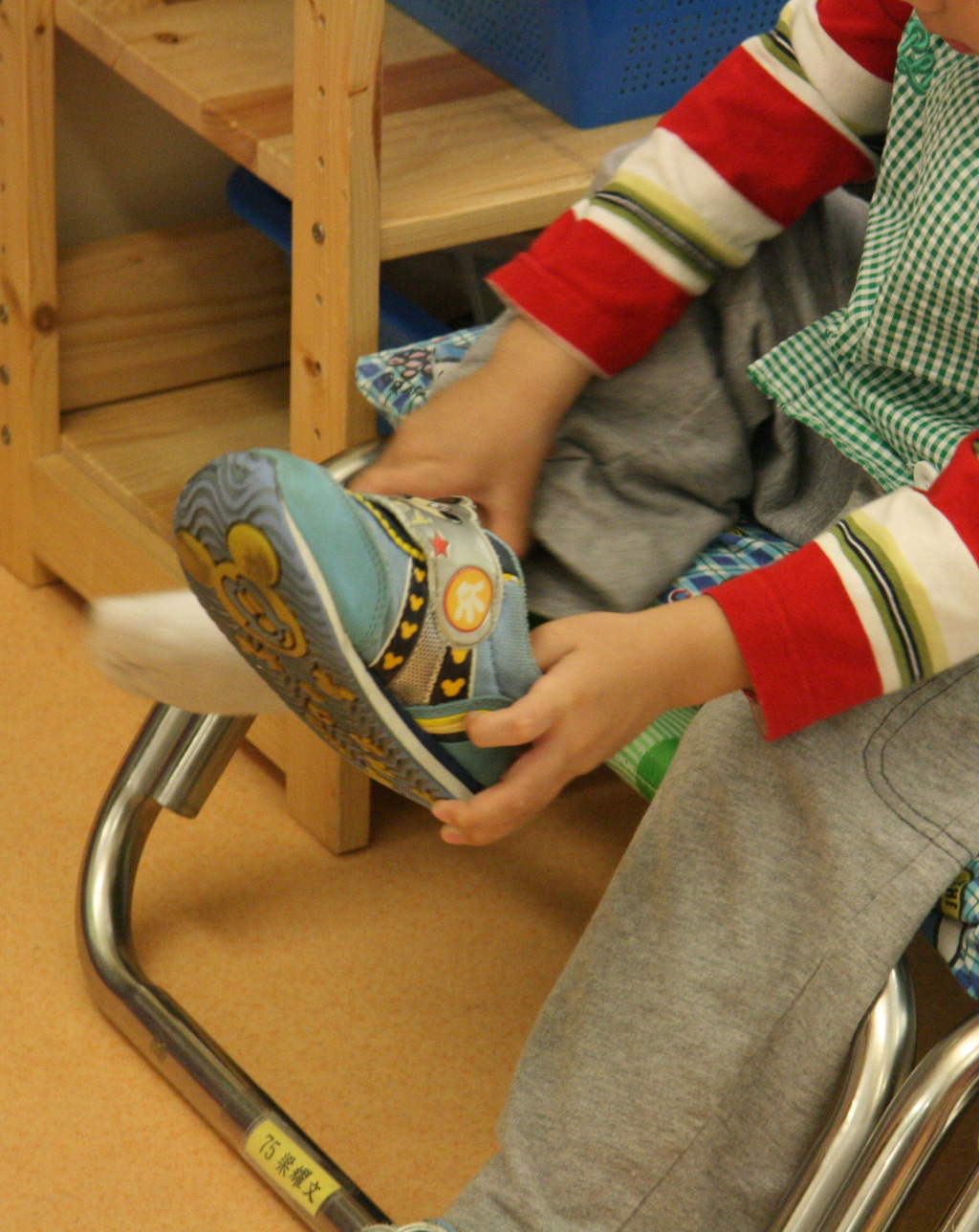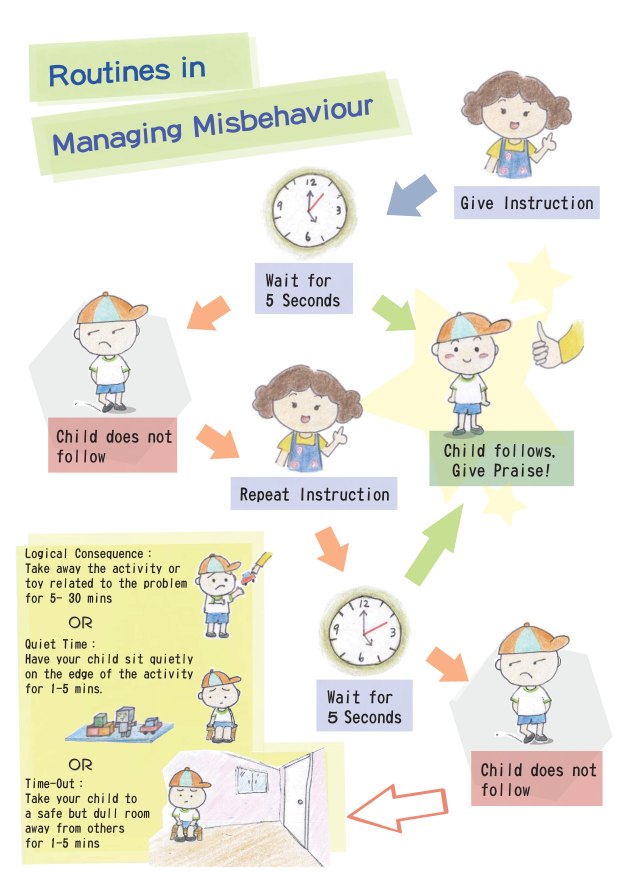Positive discipline is using constructive and non-hurtful ways to promote the development of social behaviours and positive self-concept in your child. Through firm and positive discipline, your child understands your expectations and develops self-control through repeated experience.
When your child misbehaves, positive and effective management strategies are required. Remember to try mild strategies first and use back-up techniques like “Quiet Time” or “Time Out” sparingly as they are for more serious behaviour.
Discipline Toddlers in a Positive Way (Applicable to 2 Years Old and Above)
Narrator: Discipline toddlers in a positive way (Applicable to 2 years old and above)
Scene: Hinz and Jackie are playing in the living room but they are fighting for toys. Mum is reading a magazine on the sofa. Jackie seeks Mum's help.
Narrator: Through assertive and positive discipline and with repeated experiences, children learn to follow rules, get along with others and gradually develop self-control.
Narrator: Hinz and Jackie are playing in the living room, but Hinz doesn't share his toy with Jackie, so Jackie goes to Mum for help.
Narrator: When Mum asks her if she wants to play with Hinz's toy, Jackie nods.
Scene: Mum takes Jackie to Hinz and teaches Jackie to ask Hinz for the toy.
Narrator: Mum takes Jackie to Hinz and teaches Jackie to ask Hinz for the toy.
Scene: Hinz lets Jackie play his toys and they play together.
Narrator: Hinz agrees and they play together.
Narrator: Mum smiles and praises them for sharing.
Narrator: Mum has just used positive discipline to encourage her children to develop desirable behaviour.
Heading: Setting Ground Rules
Narrator: Setting ground rules.
Scene: Mum, Hinz and Jackie are chatting on the sofa. Mum explains the household rules one by one to them.
Narrator: Ground rules can prevent misbehaviour in children and serve as good reminders if they break the rules.
Narrator: Mum, Hinz and Jackie are sitting on the sofa setting some rules, including putting away their school shoes when they get home.
Narrator: Three to four rules are good enough. Remember to keep the rules simple and easy to follow.
Scene: Photos of caregivers and children.
Sub-heading: Be a role model and follow through consistently
Narrator: Discipline is effective when all caregivers carry it out consistently.
Scene: Mum, Hinz and Jackie just get back from school.
Narrator: Mum, Hinz and Jackie just got back from school. Mum asks the kids what they should do.
Scene: Mum, Hinz and Jackie take off their shoes upon entering the house.
Narrator: Mum, Hinz and Jackie take off their shoes upon entering the house.
Scene: Hinz takes his school bag to the bedroom, but Jackie leaves her school bag on the floor.
Narrator: Then, Hinz takes his school bag to the bedroom, but Jackie leaves her school bag on the floor. Mum guides Jackie to recall the rule of putting back her school bag.
Narrator: Hinz leads Jackie with her school bag to the bedroom.
Scene: Mum is talking with the Hinz and Jackie in the living room.
Sub-heading: Clear instruction
Narrator: Mum asks Hinz and Jackie to wash their hands while she gets some snacks for them.
Narrator: Children understand clear instructions more easily.
Scene: Hinz and Jackie wash their hands in the bathroom and then wait for Mum on the sofa.
Narrator: Hinz and Jackie wash their hands in the bathroom and then wait for Mum on the sofa.
Heading: Managing Disobedience
Narrator: Managing disobedience
Scene: Hinz and Jackie are waiting on the sofa and Mum passes each one of them a bowl.
Narrator: Mum praises them for following the instructions.
Narrator: The phone rings and Mum tells them she has to take the call first.
Scene: Hinz and Jackie look at Mum while she is talking on the phone.
Narrator: It is an important phone call and Mum is jotting down some notes.
Narrator: Hinz becomes impatient and keeps pulling Mum's sleeve. Mum pauses and asks him to wait for a while.
Scene: Mum ignores Hinz even he keeps interrupting her.
Narrator: Disregarding what Mum has just said, Hinz keeps interrupting her and pulling her sleeve.
Sub-heading: Planned ignoring
Narrator: By using “planned ignoring”, Mum withdraws her attention to Hinz's undesirable behaviour.
Scene: Hinz hangs up Mum's phone and the line is cut. Mum speaks to him calmly.
Narrator: However, Hinz presses the button of the phone and cuts off the line.
Narrator: Mum keeps calm and uses “quiet time” for his noncompliance.
Scene: Hinz resists to sit down on the “quiet time chair”, Mum gently hold him down onto the seat.
Sub-heading: Quiet time
Narrator: Mum uses “quiet time” by taking Hinz to a corner of the living room.
Scene: Hinz sits down; Mum tells him to be quiet before she let him leave the chair again.
Narrator: She lets him sit down on the “quiet time chair”. If your child resists, you may embrace his upper arms or body from behind or hold him down gently. Mum tells Hinz to be quiet for 2 minutes before she lets him leave the chair.
Scene: Mum walks away and talks with Jackie. Hinz sits down quietly.
Narrator: Then, Mum walks away and talks with Jackie.
Narrator: Quiet time starts when your child calms down. During that time, withdraw your attention.
Scene: Hinz has been sitting down quietly for 2 minutes; Mum takes him for snacks.
Narrator: When your child is quiet and time is up, you may let him leave the chair.
Scene: Hinz eats the snacks happily while chatting with Mum and Jackie.
Narrator: Let him resume his previous activity and praise him for any good behaviour. Remember, as he has already experienced the consequences for disobeying you, there is no need to preach to him right away and upset him again.
End Shot: Department of Health logo
The Department of Health owns the copyright of this digital video.
This digital video is produced solely for non-commercial use.
It should not be rented, sold or otherwise used for profit-making purposes.
Produced in 2015
Steps in disciplining your child:
Set up 2 to 3 simple house rules (e.g. Leave the seat only after finishing the meal; put away the shoes when entering the house)
- To prevent misbehaviours and prepare you for managing disobedience of your child
- The rules have to be simple, easy to understand and appropriate to your child's developmental level
- Use positive wordings for the rules
For example,
- say “Leave the seat only after finishing the meal” instead of “Don't go away!”
- say “Put the toys down gently” instead of “Don't cast toys!”

Give clear instructions
- Be brief, direct and use positive words in giving instructions. Remember to give instructions in statements instead of asking “Could you?” as this will give a chance for the child to refuse.
- The rules have to be consistent and firmly followed through by all the caregivers.
What strategies are effective for managing the misbehaviours of your child?
Planned Ignoring
- For dealing with child's mild tantrums, attention seeking or other minor problem behaviours which are non-harmful.
- Withdraw your attention totally and do not respond to your child.
- Once he stops, give him attention immediately such as talking to him. Look for opportunities to praise his appropriate behaviour.
- The problem behaviour may get worse initially. However, be persistent and keep ignoring. He will learn that the act cannot attract your attention and thus do less of the act gradually.
Logical Consequence
- When your child misbehaves, you may let them bear appropriate consequences, such as pausing the activity or removing the toy that triggered the problem behaviour for a few minutes to no more than 30 minutes.
- Once he stops, return the toy to him, or let him resume his activity. This allows him to have more practices in following rules.
Quiet Time
- Use the strategy when your child does not obey or disturbs others.
- Bring your child to the edge of the activity area or a corner where he can watch the activity going on. Let him sit quietly for 1 to 5 minutes. Do not pay him any attention.


- If he refuses to sit down, you may gently hold him down.

- When the time is up, let him resume the activity.
Time Out
- This is similar to “Quiet Time”, but it is for more serious or disruptive behaviours like big tantrums and hitting others.
- Bring your child away from others, such as in a room or at a corner. Let him sit down quietly for 1 to 5 minutes.
- The place must be safe, well-lit and without anything interesting to him.
- Never put it as a harsh punishment to threaten the child and make him frightened.
- When time is up, let him resume the activity.

Steps to help your child follow instructions
- Give clear instructions
- Wait for 5 seconds and observe
- If:
- he complies, praise him
- he does not follow, repeat your instruction
- Wait for another 5 seconds and observe
- If he follows, praise him
- If he still does not follow, you may try:
- Logical consequence - Pause the activity or remove the toy related to the problem behaviour for 5 to 30 minutes, OR
- Quiet time - Let him sit aside for 1 to 5 minutes while he can still watch others, OR
- Time out - take him away from others to a room or a place which is safe and lack of interesting things for 1 to 5 minutes

